Our rivers and streams are highly valued for the wide variety of social, cultural, recreational, environmental, and economic services they provide. These include water sports, fishing and marroning, nature-based recreation and ecotourism, and water supply for a range of agricultural, industrial, and urban uses.
A properly functioning ecosystem supporting native biodiversity is critical to maintaining the intrinsic values of rivers and the essential services they provide. However, because of our use of rivers and the development pressures they face, aquatic ecosystems are exposed to significant and increasing stress. Notable impacts include changes to natural flow patterns and connectivity (interrupting species migrations and flushing), poor water quality, reduced instream and fringing vegetation and habitat, and introduction of exotic species (which predate and/or compete with native species and bring disease and parasites).
The more stress our environmental systems face, the less they are able to tolerate and adapt to a changing climate, pressures from expanding and intensifying development, and increased frequency and magnitude of bushfires.
Summary of river health
The three main river systems in the Peel Harvey Estuary catchment are the Serpentine, Murray, and Harvey Rivers. Since 2008, river health assessments have been conducted at 25 sites in the Peel Harvey Estuary catchment, under the department’s Healthy Rivers program. This includes targeted assessments during the 2017-2020 Regional Estuaries Initiative to investigate key areas of the catchment that previously had little or no data. Some sites have been assessed on multiple occasions to capture seasonal and interannual variation. Information from these assessments was examined under the Regional Estuaries Initiative to assess the status of values and threats.
Based on historical data, 16 native fish and freshwater crustacean (crayfish and shrimp) species have been recorded in the Peel-Harvey catchment. Eleven of these species are endemic to the South West of Western Australia, which means that these species are not naturally found anywhere else.
The department’s standard methods for assessing river health include collecting comprehensive data on water quality, fringing vegetation, flow, land use, and aquatic habitat, as well as the aquatic biodiversity, as described in more detail below. The biodiversity status is established by comparing the observed native and exotic species to those expected for each subcatchment, where the expectations are based on historical records. At the majority of sites assessed in the REI period, almost all of the native fish and crustacean species expected for the subcatchment were found.
However, the river health assessments highlighted that there are ongoing pressures and stressors in the system, including:
- clearing of the fringing vegetation that is critical to the functioning of rivers in south-west WA
- erosion of banks, particularly in areas that have been cleared, resulting in sedimentation (sediment accumulation) downstream with negative impacts on aquatic habitat
- high richness of exotic species (10 species)
- salinisation in the upper Murray River catchment (Hotham and WIlliams Rivers)
- altered hydrology and modified channels for increased drainage/irrigation, including the presence of on-stream dams and barriers (impacting flow regimes and fish passage)
- eutrophication from excess nutrient run off, contributing to increased incidences of algal blooms and impacting water quality (dissolved oxygen), resulting in fish kills.
Note that the recent assessments were not an exhaustive survey of the current status of the entire catchment, however, the new data now adds to our knowledge base of how WA river systems function in different circumstances. The data also provides a baseline for ongoing monitoring of the health of the rivers in the catchment.
River health assessments
Site names for assessments carried out between 2017-2020 were:
On the Serpentine River system:
- Lower Nambeelup Brook
- Lower Punrack Drain
- Serpentine downstream Peel Main Drain
- Lowlands
On the Murray River system:
- Buchanans Drain
- Murray-Marrinup
On the Harvey River system:
- Downstream Drakes Brook Dam
- Clifton Rd
- South Western Highway
- River Rd
Three sites were also situated just outside the Healthy Estuaries WA catchment, in the Harvey catchment:
- Homestead Rd HRP, Harvey River
- DS Wokalup Dam HRP, Wokalup Creek
- US DrakesBk Dam HRP, Drakes Brook
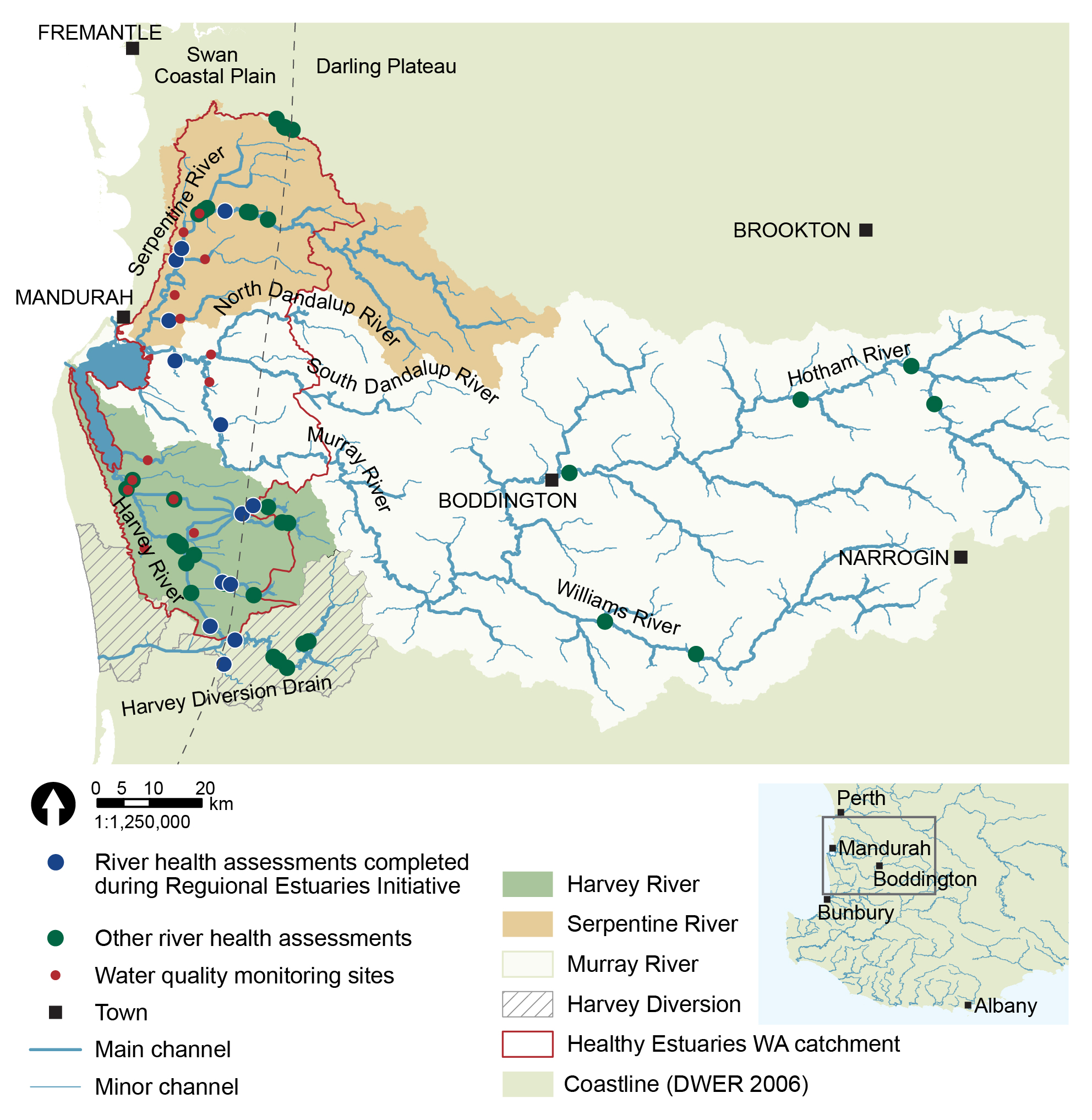
Aquatic biota
Based on both recent and historical data, 16 native freshwater and freshwater-estuarine species have been found in the Healthy Estuaries catchment, including four species of native crayfish and the south-west glass shrimp, and one species with conservational significance, the pouched lamprey. Eleven of these species are endemic to the South West of Western Australia, which means that these species are not naturally found anywhere else
Ten exotic species have been observed, including eight fish, one crayfish and one exotic shrimp.
Other native species recorded include native water rat (rakali), south-western snake necked turtle and Carter’s freshwater mussel (which is also a species of conservational significance).
Native species (Click for more information)
Green border indicates species with conservational significance
Western pygmy perch
Blue-spot goby
Nightfish
Western minnow
Freshwater cobbler
Western hardyhead
South-west goby
Black bream
Sea mullet
Jollytail
Lamprey
Gilgie
Smooth marron
Koonac
Restricted gilgie
South-west glass shrimp
Yabby
Gambusia
Redfin perch
Rainbow trout
Goldfi
One-spot livebearer
Brown trout
Sooty grunter
Sooty grunter
Common carp
Indistinct river shrimp
Water rat (rakali)
South-western snake necked turtle
Carter's freshwater muscle
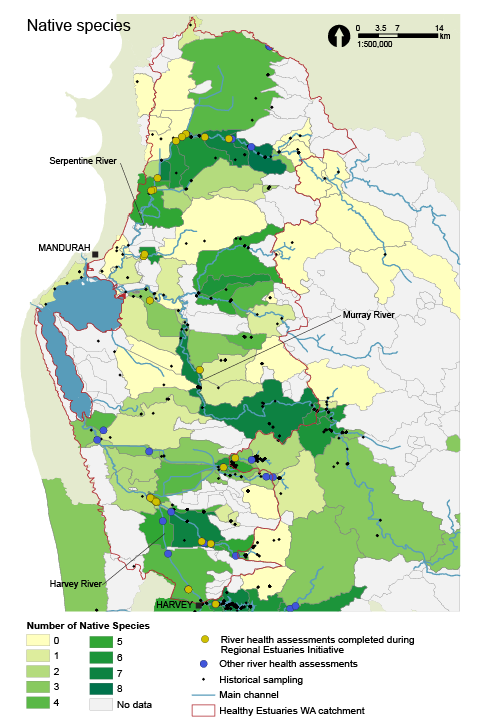
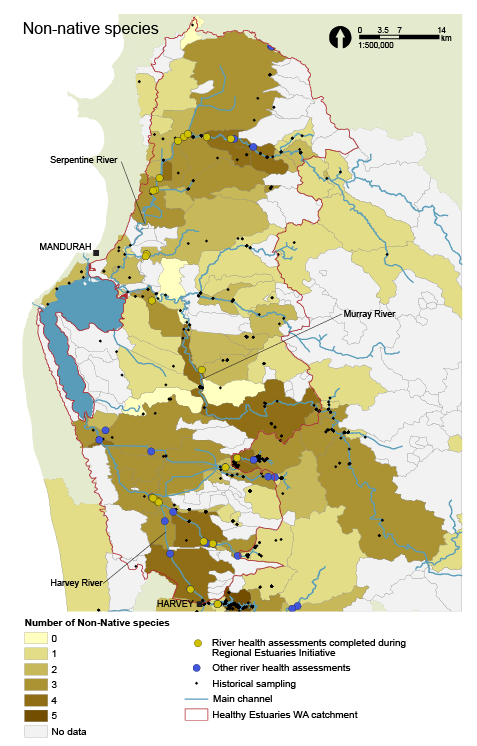
The river health assessments conducted during the Regional Estuaries Initiative (2017-2020) found eight native species and six exotic species. The native species included six native fish (sea mullet, freshwater cobbler, western pygmy perch, western minnow, nightfish and western hardyhead - the last five being endemic to South West WA) and two endemic freshwater crayfish (gilgie and smooth marron). Lamprey are rarely caught in traps given a very short migration period as adults, and as ammocoetes (larvae/juveniles) largely remain buried in sediment in localised habitats, as such their absence in traps is not considered to reflect their absence in the system. Similarly, although the restricted gilgie and koonac are expected in the catchment based on earlier reports, the 10 sites sampled were not located in the preferred habitat for these species in this region.
Six exotic species were recorded, including four fish (gambusia, goldfish, redfin perch, rainbow trout), one crayfish (yabby), and the indistinct river shrimp. The yabby is often mistaken as a native species in WA but it is actually native to Eastern Australia and a problematic pest in WA. The exotic indistinct river shrimp was also recently discovered in the Serpentine River in 2017. This shrimp is very similar in appearance to the native south-west glass shrimp and has the potential to compete with and displace the native species, as many exotic species have done in WA waterways.
Some less commonly found species in the assessments since 2017 include the Carter’s freshwater mussel, which is listed as vulnerable under state legislation. The mussel was recorded in the Serpentine and Harvey River catchments. The rakali was observed in the Harvey catchment; this reclusive, semi aquatic native rat is classed as near threatened in WA due to urbanisation, salinity and habitat loss and degradation. South-western snake necked turtles were also recorded.
Hydrology and landuse
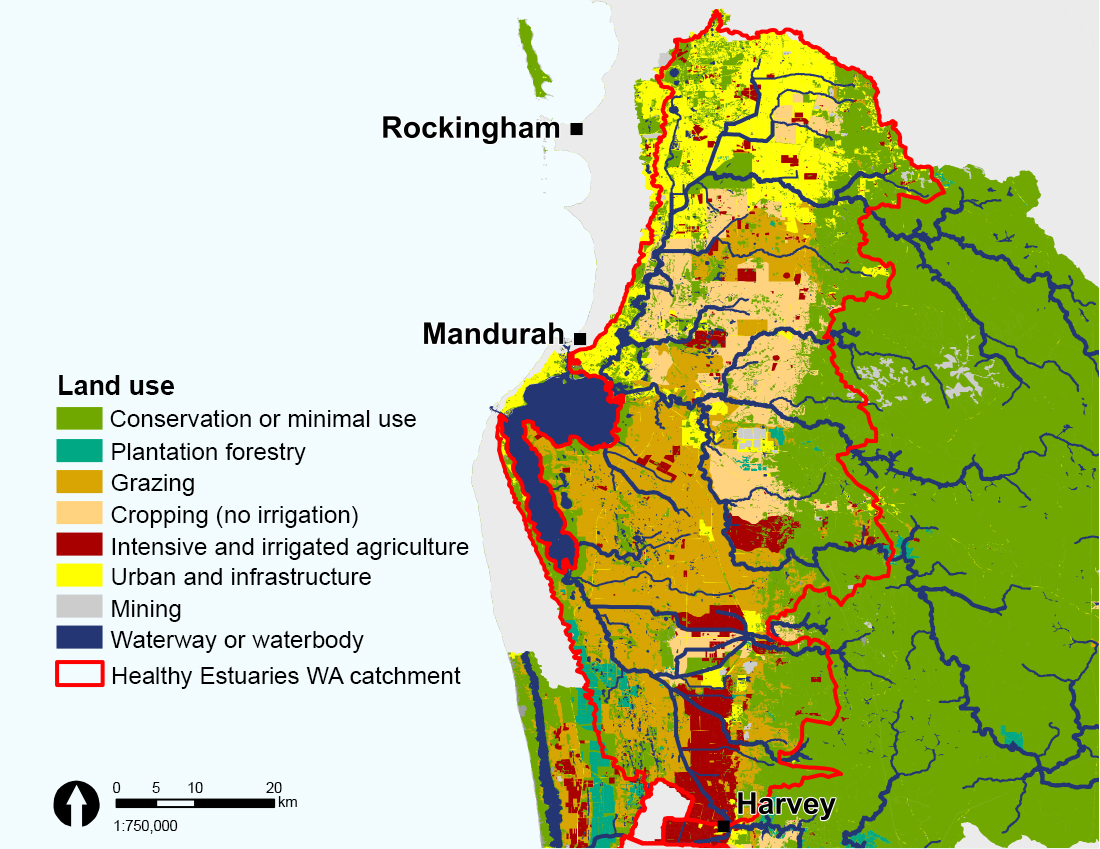
The Peel Harvey hydrographic catchment covers over 10,000 km2 (distinct from the Healthy Estuaries WA catchment action area). Land use has been substantially modified since European settlement. Within the Healthy Estuaries WA catchment action area, approximately 75% of the land has been cleared. Clearing of land for agriculture has resulted in widespread loss of vegetation cover, with only the Darling Scarp and Lowlands Reserve retaining any significant areas of remnant native vegetation.
Land use on the Darling Plateau (east of the Darling Range and the Healthy Estuaries WA catchment) is dominated by grazing and cropping through the upper Murray River catchments in the wheatbelt. Land use on the Swan Coastal Plain tends to be more intensive, including cattle feedlots and intensive and irrigated horticulture. Between the wheatbelt and the Swan Coastal Plain, through the Darling Range, land use is predominantly conservation and managed resources (e.g. state forest). Closer to the coast, there is widespread urban land use, with the southern metropolitan area of Perth extending into the north of the catchment.
Natural flows in the catchment have been heavily modified by the construction of 15 dams for water supply and flood control, and a network of artificial drains. The notable exception is the Murray River, which is the largest of the three river catchments by land area, yet is one of the few rivers in south-west WA with no dam on the main river channel, and dams on only a few tributaries. In contrast, the Harvey River catchment is a complex network of diversion drains, dams and water trading, including the Harvey, Logue, Drakes and Wokalup systems and the Harvey Diversion Drain. Irrigation water is also introduced to the Harvey catchment from the Collie River catchment via Burekup Weir. Prior to 2010 many of the rivers in the Harvey River system were used for transferring water for irrigation resulting in high summer flows. In 2010 a pipeline was completed to pipe most of the irrigation flows, this also resulted in much lower flows in the rivers. Many of the dams on the Harvey River have environmental water release regimes to help maintain aquatic habitats and social value over the dry season and regulate flows to the downstream environment.
Modifications to drainage (for flood relief and irrigation), damming and clearing of native vegetation have significant impacts on hydrological regimes, which in turn impacts associated flora and fauna. Sections of river channel (particularly on the Serpentine and Harvey Rivers, and their tributaries) have been straightened to improve drainage and reduce localised flooding during high seasonal flows. Whilst clearing of vegetation in the upper part of the catchment has inherently increased the water table (often dissolving salts in the soil as it rises and increasing stream salinity) resulting in increased flows. The resulting higher flow velocities combined with straightening of previously meandering river channels has led to increased erosion and sedimentation, and reduced riparian vegetation, instream habitat and connectivity for aquatic species.
Vegetation, physical form and habitat
Historical clearing of land for agriculture and urban development, has left a legacy of a reduced fringing vegetation. Vegetation is often degraded, with a high proportion of exotic species, impacting the natural physical form of river channels and altering their behaviour and movement in the landscape. Salinisation is another well documented problem arising from the clearing of deep-rooted vegetation like trees; this has occurred in the upper parts of the Murray River catchment in the wheatbelt (Williams and Hotham Rivers).
Sites with more extensive and intact fringing vegetation tend to provide a more diverse and varied habitat for aquatic animals. Conversely, channelised and cleared reaches such as drains, provide less optimal habitat and shelter for native species.
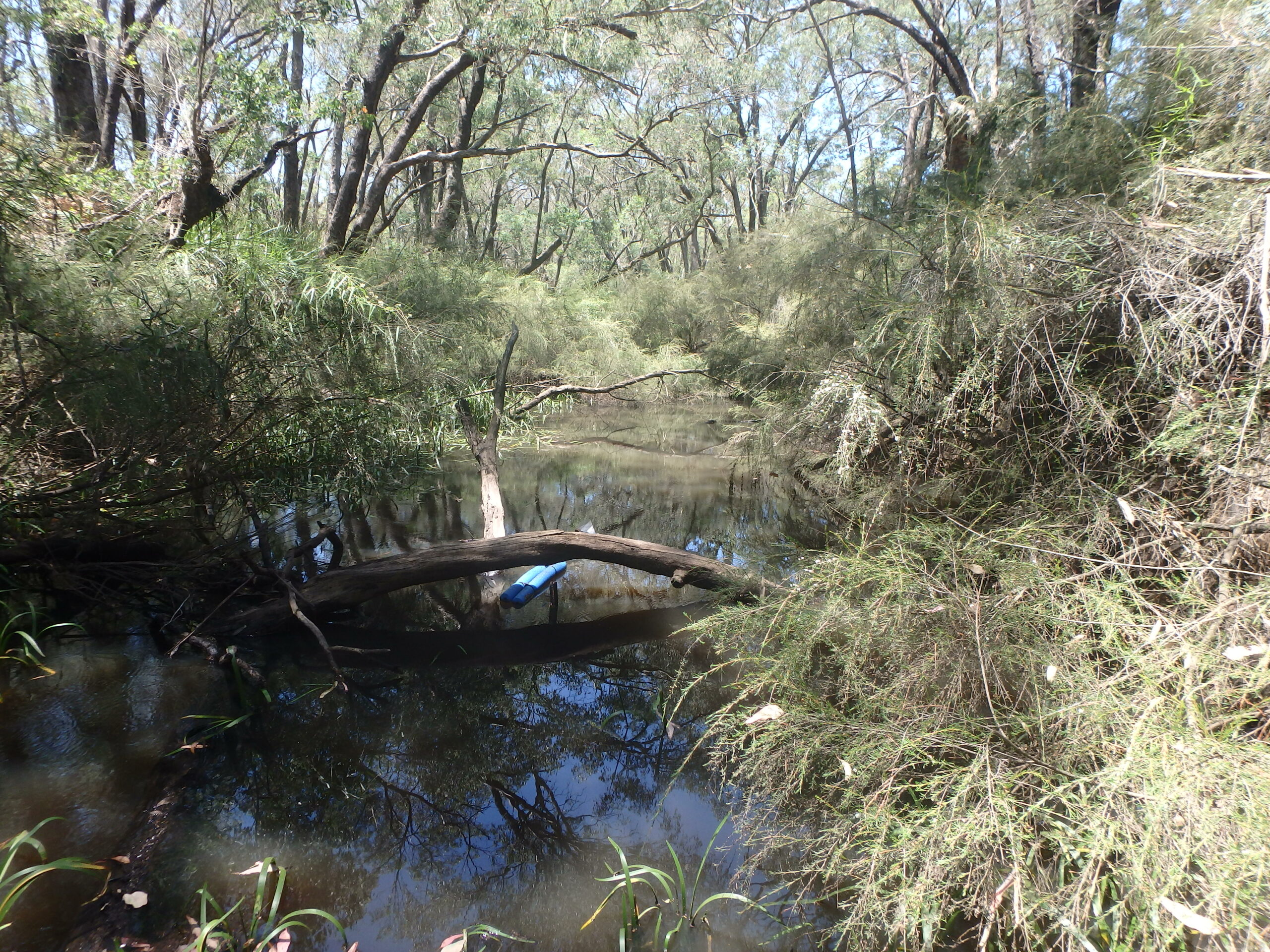
Lowlands site (MR127-SERP1)
Many sites assessed in rural areas through the Peel-Harvey catchment displayed the common symptoms of reduced fringing vegetation, with a reduced understory (shrubs and ground cover) that was often dominated by invasive weeds.
Two contrasting examples of healthy and poorly vegetated stretches of river and the associated effects on ecology were observed on the Serpentine River. On the upper to mid Serpentine River, the Lowlands site (MR127-SERP1) within Lowlands Reserve had near pristine vegetation. This reserve is vested with the Department of Biodiversity, Conservation and Attractions and lies at the western edge of a more than 1,300 hectare block of remnant vegetation. The site has a broad corridor of healthy native tree, shrub, and ground cover, and an absence of weeds along with optimal aquatic habitat that encompassed overhanging vegetation, abundant woody debris and in-stream aquatic macrophytes along with variable stream bed substrate and depth and flow; all of which provided a variety of habitat and food for aquatic fauna. This site also exhibited healthy aquatic habitat and fauna, with a healthy abundance of native species and low abundance of exotic species.

Near the intersection of Serpentine River and Peel Main Drain
The conditions within the other site, only a few kilometres downstream (near the confluence of the Serpentine River with the Peel Main Drain), were significantly altered from their natural state. The site is a straightened floodway channel with levees on either side, no shading trees or shrubs, and a ground cover of exotic grass. The aquatic habitat was in poor condition and displayed a limited variety of habitats, which is important for supporting a robust ecological food web. This is reflected in a high richness and abundance of invasive exotic species.
The comparison between these two sites on the same river, only kilometres apart, highlights the importance of healthy native fringing vegetation to support a healthy in-stream habitat and aquatic animal community.
Rivers that are significantly cleared of native vegetation tend to be subject to erosion. Excessive sediment is washed away from riverbanks and accumulates downstream, often smothering the benthic habitat on the riverbed. The loose, sandy soils of the Swan Coastal Plain are particularly susceptible to erosion if not supported by adequate streamside vegetation. Erosion is evident on exposed banks in the Harvey and Murray Rivers, and along Punrak Drain in the Serpentine River system. Sites with intact remnant vegetation tend to display more natural, optimal channel form.
Water quality
Intensive urban and agricultural land uses can lead to nutrient enrichment of waterways. Nutrient enrichment can lead to increased frequency and severity of harmful algal blooms and fish kill events. Both these effects are longstanding issues in the lower reaches of the Serpentine and Murray rivers, as well as in the Peel-Harvey estuary. Water quality (nutrients, salinity, pH, and total suspended solids) is monitored at a number of sites across the Healthy Estuaries WA Peel-Harvey catchment. For seasonal and longer-term trends for individual monitoring points, please see the catchment nutrient reports.
The water quality (dissolved oxygen and temperature) observed at the river health assessment sites in 2017-2020 indicated that conditions often exceed tolerance thresholds for native fish. For example, monitoring overnight indicated that the dissolved oxygen drops to concentrations that fish cannot survive. This is often the cause of fish kill events, in particular in the lower reaches of the Murray and Serpentine Rivers. These events tend to affect the larger bodied and recreationally valued fish species such as southern black bream. Of the fish kills reported to DWER between April 2016 to Sept 2020 in all Healthy Estuaries WA catchments, over half (13 out of 21) were in the Peel-Harvey catchment, predominantly in the lower reaches of the Serpentine and Murray Rivers - generally due to poor water quality, particularly low dissolved oxygen.
Salinisation affects most of the Murray catchment on the Darling Plateau (Hotham and Williams Rivers), but not to the same extent on the Swan Coastal Plain, nor in the other rivers. Increased salinity is detrimental to native freshwater fish and crayfish and also impacts streamside vegetation, altering the species composition and overall ecology.

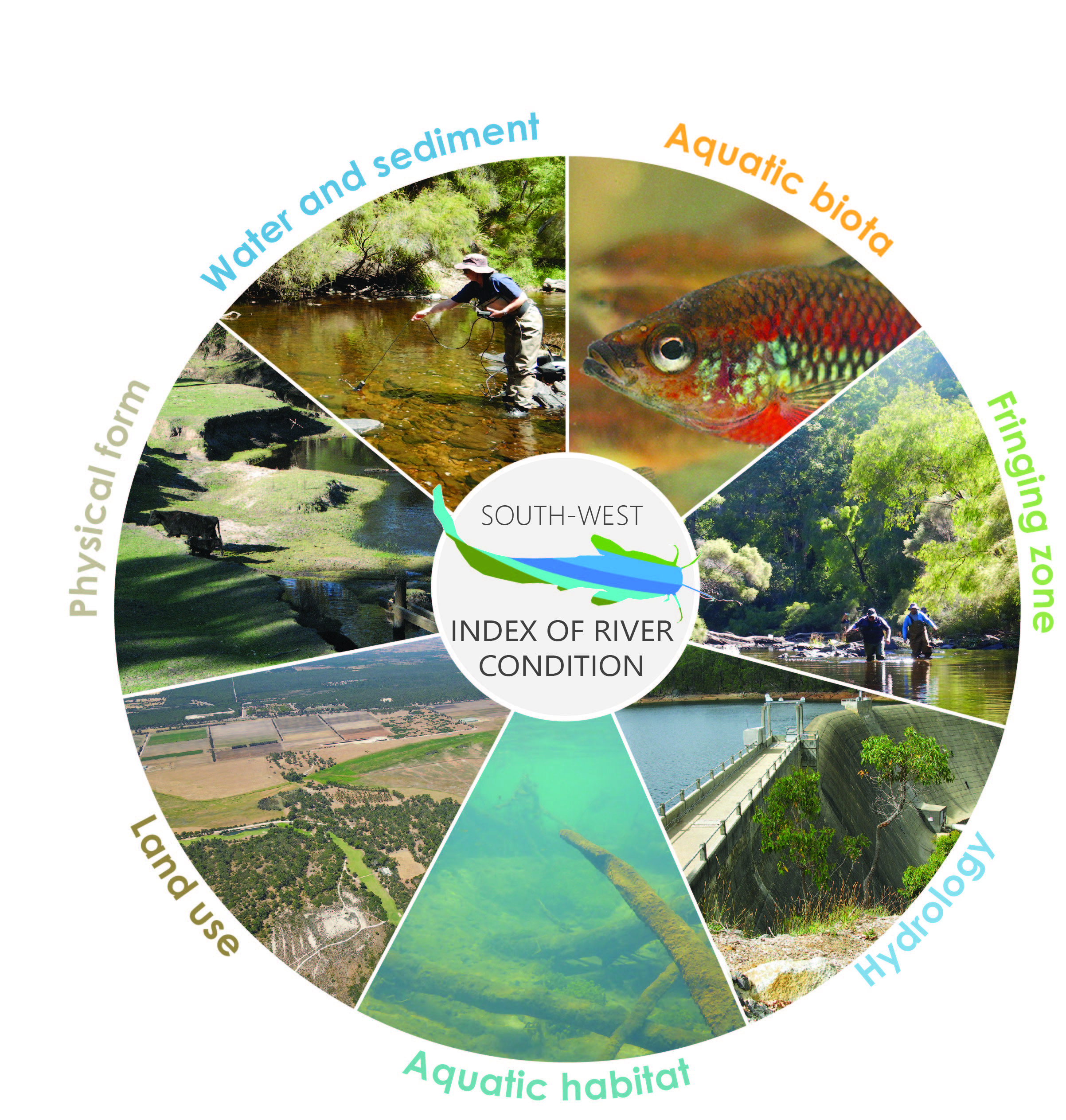 River health assessments were carried out using the
River health assessments were carried out using the